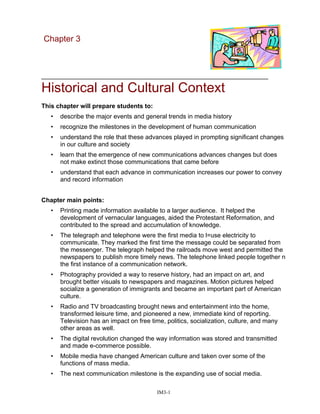This chapter discusses the major developments in communication technology throughout history and their cultural impacts, including:
1) Printing helped standardize languages and spread knowledge during the Reformation. The telegraph and telephone conquered space and time by allowing instant communication.
2) Photography and motion pictures brought visuals to publications and changed leisure activities. Radio and TV broadcasting brought news and entertainment into homes.
3) The digital revolution changed how information is stored and transmitted, enabling e-commerce. Mobile media took over some mass media functions and changed etiquette.
4) Social media opened new channels for connecting people through sites like Facebook and Twitter. Each new medium changed culture while older media continued alongside.








